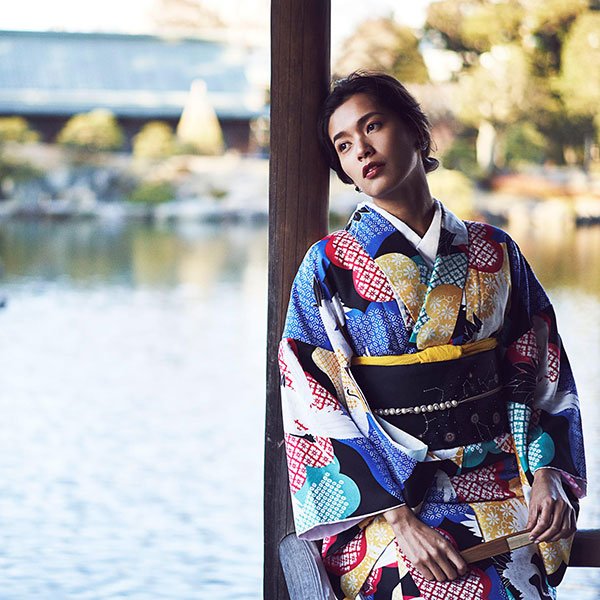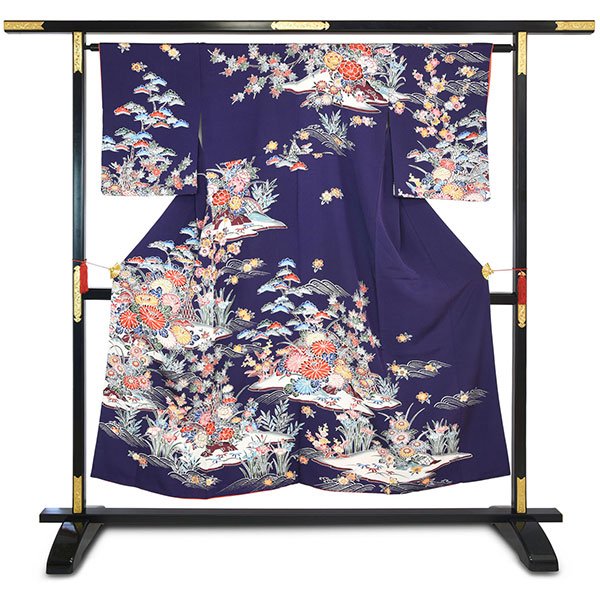© Kimono by Kaga Yuzen
The Japanese kimono is renowned for its exceptional beauty. It is a sublime art form that has produced many outstanding designs throughout the centuries.
Here are examples of the most iconic and unique kimono artists and styles that will guide you through the sumptuous world of kimono art.
The Timeless Style of Kyo-Yuzen
© Kimono by Chiso, photography by Yoshikiho Ueda
The Kyo-Yuzen dyeing technique showcases the highest standard of kimono arts, an array of lavish designs originally reserved for the aristocratic class in the 17th century palaces of Kyoto.
Established by master painter Miyazaki Yuzensai, this hand-painted technique employs stencils to create patterns with extremely precise lines and one-of-a-kind color gradations. It often accompanied by exquisite embroidery, along with gold and silver leaf.
Splendid Japanese nature in Kaga-Yuzen
Autumn, Woodblock print by Tomimaro Higuchi, 1946
Kaga-Yuzen, rooted in the castle city of Kanazawa, is renowned for its painterly expressions of floral designs and delicate seasonal colors that have been cultivated for over 500 years.
Using a palette of just five colors, Kaga Yuzen artists paint intricate natural designs onto the white kimono cloth, before sealing the patterns with rice paste, and dyeing the background material.
© Kimono by Kaga Yuzen
For this particular kimono, artisan Kenichi Sato used as his model the Miharu Takizakura cherry tree in Fukushima. The name means ‘cherry tree waterfall’ and describes the flower-laden cascading branches of this famous thousand-year-old tree.
The Fine Art of Japanese Kimono
© Flowering Plum Blossom Kimono by Sakai Hoitsu
Some of the finest kimono designs come from Japanese painters whose work has never been restricted to just canvas. Sakai Hoitsu (1761-1828) was better known for his work on scrolls and folding screens, but here turns his hand to the kimono.
Working with clothing affords an artist modes of expression that are not available on a flat surface. Sakai expertly employs the curved spaces of this garment to lend depth to this three-dimensional painting of a flowering plum tree.
It is important to highlight Japanese women artists and their contribution to the kimono arts as they are still significantly outnumbered by their male counterparts.
The Ingenuity of Contemporary Japanese Kimono
© Kimono by Kilji Fukada
Kiju Fukuda is the only master artisan to be designated a Living National Treasure in the field of embroidery. He has devoted his life to preserving traditional needlework passed down from the Asuka period (538-710CE). The craft techniques he uses are at risk of disappearing altogether.
Fukuda understands the challenge to keep up with the times. "If you just follow the tradition blindly, the tradition will die," he explains. "What you need to do is create something new."
© Kimono by Takahashi Hiroko
This is often the case for today’s kimono artists; it is never enough to just preserve cultural legacy. Its survival requires new innovations in design and promotion. Artist Takahashi Hiroko represents this new wave of Japanese kimono revival with her conceptual pop aesthetic and geometric patterns.
Intrigued? Delighted? Questions? We would love to hear your thoughts in the comments below!














ART | October 6, 2023